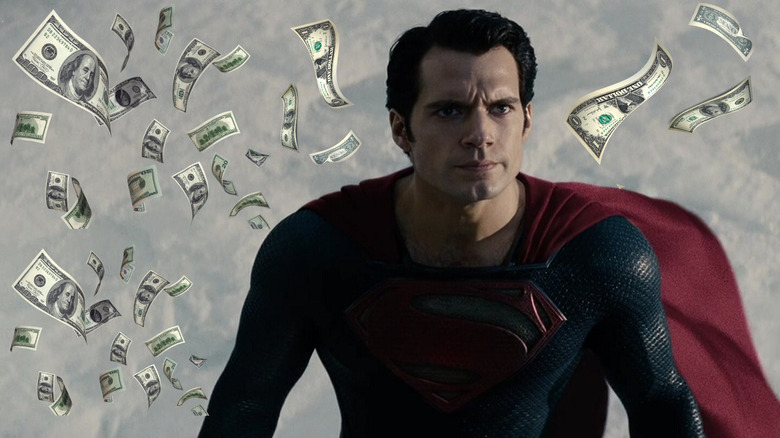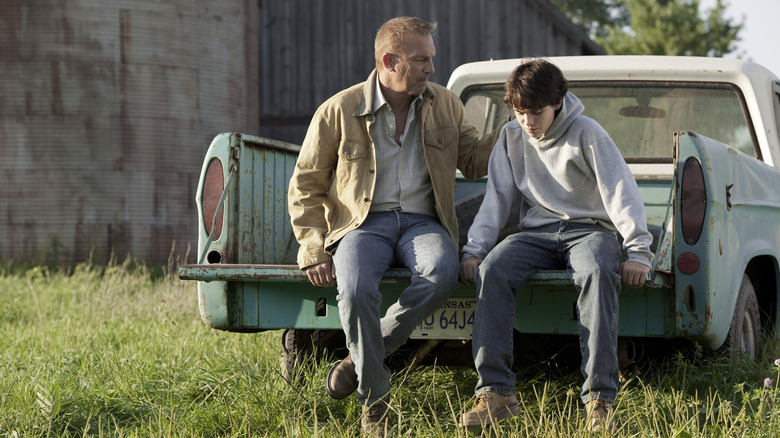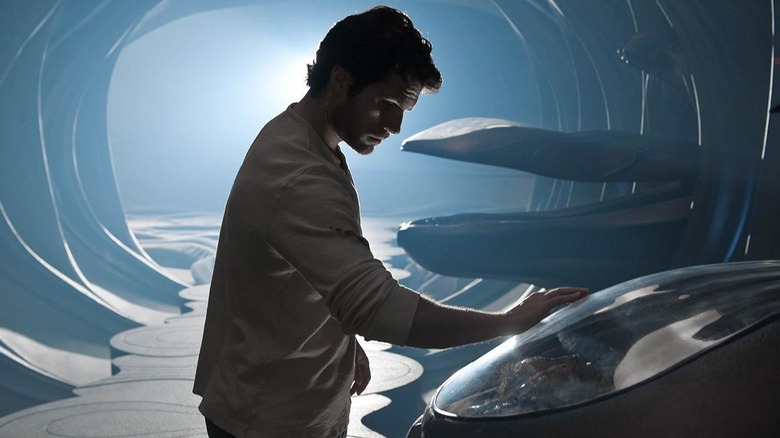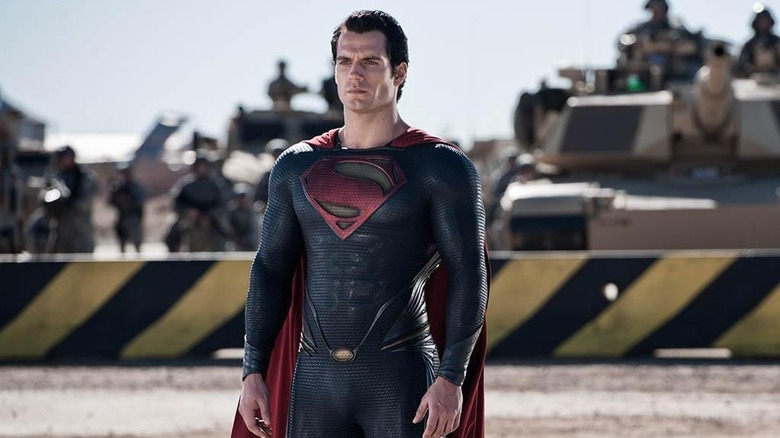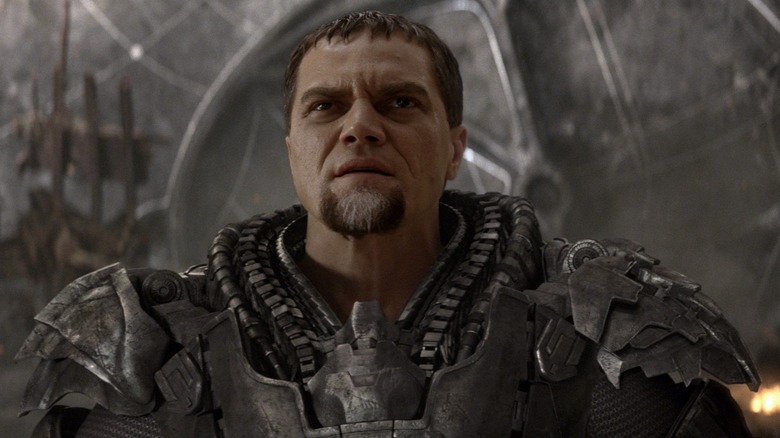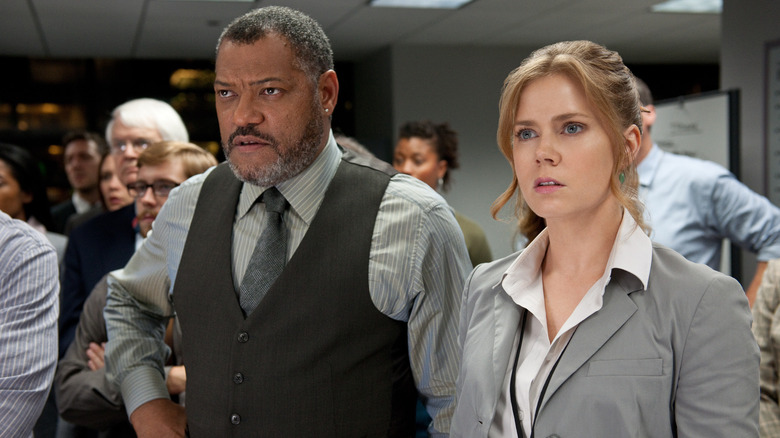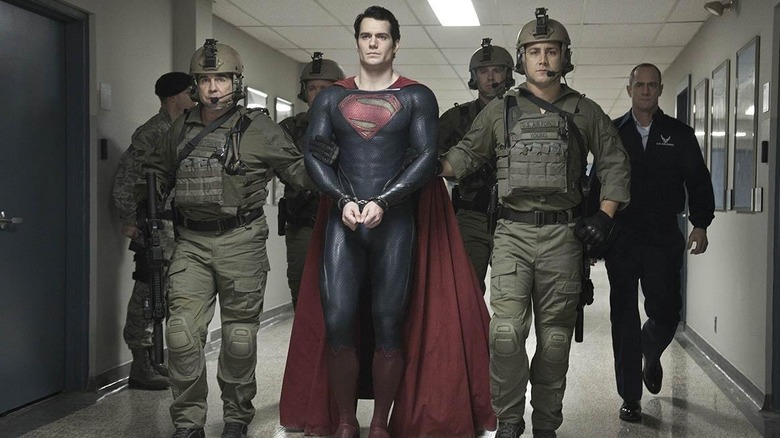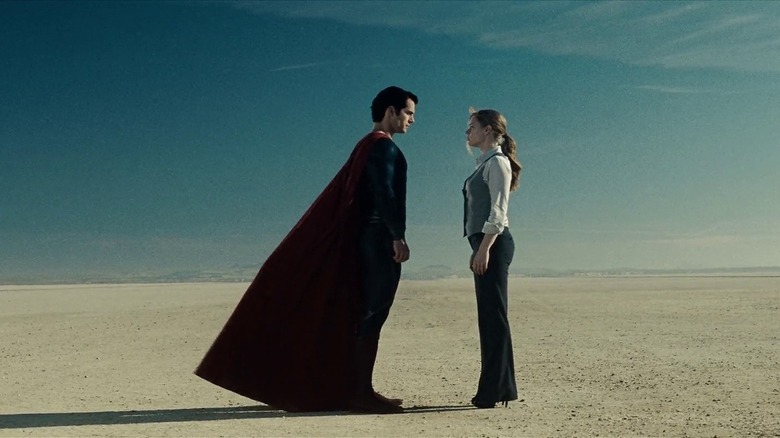Tales From The Box Office: 10 Years Ago, Man Of Steel Kicked Off DC's Messy Cinematic Universe
(Welcome to Tales from the Box Office, our column that examines box office miracles, disasters, and everything in between, as well as what we can learn from them.)
Superheroes have been the dominant force in pop culture for more than 20 years now, with Sam Raimi's "Spider-Man" truly serving as the point of no return in that regard. But it's easy to forget just how different the landscape looked even ten years ago, just as the Marvel Cinematic Universe had proven its concept of uniting multiple franchises under one roof with "The Avengers" in 2012. By 2013, that's what absolutely everyone wanted to do. Most notably, Warner Bros. was determined to make that happen with DC, having just wrapped up Christopher Nolan's Batman trilogy with "The Dark Knight Rises."
Whether or not it was the intention at the outset, the beginning of that cinematic universe rested on Superman's shoulders and was delivered to us in the form of Zack Snyder's "Man of Steel" in the summer of 2013. A visionary director, a seemingly perfect cast led by Henry Cavill as Superman, and a bold new take on the classic superhero to help set it apart — what could possibly go wrong? In short, Warner Bros. wanted too much too fast, and Snyder was happy to try and give it to them.
In honor of the movie's 10th anniversary, we're looking back at "Man of Steel," how it came to be, how Zack Snyder tried to reinvent Superman for modern audiences, what happened when the movie hit theaters, and what lessons we can learn from it a decade removed. Let's dig in, shall we?
The movie: Man of Steel
The journey of "Man of Steel" in many ways starts in 2006 when Bryan Singer's "Superman Returns" hit theaters, serving as a major disappointment. The film earned just $391 million worldwide against a hulking $232 million budget. Singer worked his magic with the "X-Men," but it didn't translate to the DC universe. But, as mentioned, superhero movies were booming, so Warner Bros. didn't wait too long to try and bring Clark Kent to life once again.
Mark Millar ("Kick-Ass") and other writer/director teams pitched on a new "Superman" film around 2008. Millar even had plans for a full trilogy that never materialized. In August of 2008, then-Warner Bros. president Jeff Robinov confirmed that a reboot was in the cards, saying the following:
"Superman [Returns] didn't quite work as a film in the way that we wanted it to. It didn't position the character the way he needed to be positioned. Had Superman worked in 2006, we would have had a movie for Christmas of this year or 2009. But now the plan is just to reintroduce Superman without regard to a Batman and Superman movie at all."
No doubt inspired by what Christopher Nolan had accomplished just months earlier with "The Dark Knight," Robinov also offered this rather crucial nugget in regards to the studio's approach with DC superhero movies moving forward: "We're going to try to go dark to the extent that the characters allow it."
Speaking of Nolan, "Man of Steel" actually starts with him (he's credited as a writer and producer on the film) and David S. Goyer, who he worked with on "The Dark Knight" trilogy. While trying to crack "The Dark Knight Rises," Goyer pitched Nolan his take for a modern take on Superman. Nolan loved it. "It was the first time I had been able to conceive of how you would address Superman in a modern context. I thought it was a very exciting idea," Nolan said of Goyer's pitch in 2010.
Zack Snyder enters the DC universe (again)
In that same interview, Nolan said they were "trying to find the right person" to take the project forward. That person was Zack Snyder. The filmmaker behind "300" was announced as the director in October 2010. In the original press release from the studio, Snyder had the following to say about his big new gig:
"I've been a big fan of the character for a long time, he's definitely the king of all superheroes, he's the one. It's early yet, but I can tell you that what David and Chris have done with the story so far definitely has given me a great insight into a way to make him feel modern. I've always felt he was kind of awesome."
Snyder was a hot name at the time and this would be the filmmaker's second trip to the DC universe, having previously directed 2009's "Watchmen." That movie was met with a somewhat mixed response, and, perhaps more crucially, earned just $185 million worldwide against a $130 million budget. Not only was it not a hit, but that's a flop by any studio's way of accounting. Still, Warner Bros. had a great deal of faith in him (to be fair, he made them an awful lot of money with "300").
Not to get ahead of ourselves here, but WB likely had a little too much faith in Snyder, as they essentially allowed him to plan the full DC Extended Universe (known by many as the Snyderverse) to try and compete more aggressively with Marvel. But first, he had to find his new, modern Superman.
Casting the new Superman
Brandon Routh played the role of Clark Kent in "Superman Returns," and if you were looking for a guy to pick up where Christopher Reeve left off, he certainly had the look to do just that. But it was clear Snyder, Goyer, Nolan, and Warner Bros. all wanted a more modern take on the character. So the studio cast a wide net looking for the perfect actor to bring a different version of Jerry Siegel and Joe Shuster's legendary character to life.
In January of 2011, it was announced that Henry Cavill, then known best for his work on "The Tudors," had landed the coveted gig. While he wasn't necessarily a known entity at the time, it's hard to deny that the British actor looked as though he was born to play the part. He didn't feel as confident, though. "All I could think was: Oh, god. They're going to look at me and go 'He's not Superman. Not a chance," Cavill said to Entertainment Weekly after he was cast. "The actor inside me was going: You're not ready! You're not ready!" Snyder had a different take on Cavill, though:
"He walked out, and no one laughed. Other actors put that suit on, and it's a joke, even if they're great actors. Henry put it on, and he exuded this kind of crazy-calm confidence that just made me go 'Wow.' Okay: This was Superman.'"
Cavill's tenure as the hero would ultimately be more than a bit rocky, as he had to share screen time with Ben Affleck's Batman in 2016's "Batman v Superman: Dawn of Justice" before moving onto the disaster that was "Justice League." (Not to mention that ill-fated "Black Adam" post-credits scene.) Even so, a great many viewers loved Cavill in the role, and that's why his actual run of films proved to be so disappointing. But at that time, it elevated him to A-list status.
A darker vision for a classic hero
Snyder surrounded Cavill with a ridiculous cast of other A-listers. Amy Adams took on the role of Lois Lane, while Laurence Fishburne played Daily Planet editor Perry White. Michael Shannon was our main villain, General Zod, with Oscar-winner Russell Crowe playing Kal-El's dad. It was a downright stunning ensemble.
"Man of Steel" largely serves as an origin story for Superman, albeit one that strives for a more grounded tone. It also goes pretty dark in the third act, with Supes controversially killing Shannon's General Zod. While that death wasn't revealed ahead of the film's release, of course, it's important to understand that Snyder's approach ran counter to what a lot of people think of when they think about Superman. That had an impact.
In general, Synder and the team approached bringing this new version of Superman to life in as grounded a way as possible. What option did he have but to kill Zod? Even the costume, down to the "S" symbol on the chest, carried in-universe meaning. As costume designer Michael Wilkinson explained in a 2014 interview with Esquire:
"A lot of the efforts we took in the film were to explain why the suit looks the way it does. We didn't want it to be a random, ornamental decision. We start the film on the planet of Krypton, which is where the suit comes from, and we go to great pains to show the suit fitting into the culture. All of the people you see on Krypton are wearing this chainmail-like suit, with the same detailing as the Superman suit. Everyone has their family crests on their chests. The cuff and the boot details are shared through all of the different characters we meet on Krypton. So by the time we see Superman in his suit we understand why it looks the way it looks."
Ready or not, the world was about to meet this Superman for the modern era, who was about to usher in far more than anyone could have understood at the time.
The financial journey
To say that Warner Bros. ran a good marketing campaign for the film would be a dramatic understatement. Say what you will of the film itself, but a great many would argue that the trailer for "Man of Steel" is, unto itself, a true work of art within the superhero genre. It put a lot of butts in seats — at least on opening weekend.
"Man of Steel" hit theaters on June 14, 2013, square in the middle of the summer movie season. On opening weekend, it was no contest, as Zack Snyder's bold new vision for Superman debuted atop the charts with a huge $116.9 million opening weekend. The only other new release was "This is the End," and that film was never truly competing for the crown. Unfortunately, the response to the film itself would prove to be mixed, and that hurt its audience retention in the weeks that followed.
Against heavy competition from "Monsters University" and "World War Z," Snyder's film fell to number three in its second weekend, plummeting more than 64% with a $41.2 million haul. Still, it went pretty well, all told, as the movie finished its run with $291 million domestic to go with a pretty stellar $377 million international haul for a grand total of $668 million. That was good enough to make it the ninth biggest movie of the year, behind "Gravity" ($723.1 million) and just ahead of "Thor: The Dark World" ($644.7 million). The only real downside was the $225 million budget. Snyder has expensive tastes.
The aftermath of Man of Steel
Here's the thing: Warner Bros. probably would have liked it if their new "Superman" flick had been received a bit better critically, but $668 million is nothing to sneeze at — not by a long shot. That being the case, it absolutely made sense to continue on in some way. However, what WB decided to do next is something we'll be examining for years and years to come. Rather than make "Man of Steel 2," in an attempt to catch up to Marvel, the studio and Snyder decided to make "Batman v Superman: Dawn of Justice," which was announced at San Diego Comic-Con that year. Ben Affleck's casting as Batman would break the internet mere months later.
Released in 2016, "BvS" ended up being far more divisive than "Man of Steel," and was vastly overshadowed in many ways by Marvel's "Captain America: Civil War." Snyder's grand superhero mash-up made a damn respectable $872 million worldwide (a miracle given the reviews), but it should have easily sailed to $1 billion given that these two heroes were meeting in live-action on the big screen for the first time. Unfortunately for Warner Bros., they were so all-in on Snyder's vision that they had already given the green light to "Justice League," which went into production mere weeks after "BvS" hit theaters. It was a recipe for disaster.
Snyder eventually departed the film, Joss Whedon was brought in to handle major reshoots/rewrites, the budget ballooned, and the end result was met with a lukewarm response. Snyder's fans begged WB to "release the Snyder cut" for years, while the studio struggled to both embrace what Snyder teed up and move away from it at the same time. The on-screen DC universe, as a result, never really felt cohesive in the way that Marvel's did.
The lessons contained within
Granted, this universe gave us huge hits like "Aquaman," which remains the highest-grossing DC movie ever, as well as "Wonder Woman." But still, the DCEU never quite came together in the way the studio needed. After struggling to sort of piece everything back together in the aftermath of a string of disappointments connected to the Snyderverse, Warner Bros. finally decided to hit the reboot button, hiring James Gunn and Peter Safran to head up DC Studios, with a reboot on the way. "The Flash" and "Aquaman and the Lost Kingdom" will, more or less, represent the end of what Snyder started.
There is no denying that Snyder has a great deal of talent and can produce a big hit. Heck, when "Zack Snyder's Justice League," the so-called "Snyder Cut," was eventually released on HBO Max, the results impressed a lot of people. Still, the problem here was always that WB went too hard, too fast on the filmmaker's grand vision for a shared universe. Marvel built its cinematic universe one movie at a time until all the pieces were in place for "The Avengers." Not making "Man of Steel 2" and instead going for broke was detrimental in hindsight. Sadly, what happened here is more of a cautionary tale in modern franchise filmmaking.
Divorced from what came after, "Man of Steel" was a pretty successful movie that, though divisive, did what it set out to do. It's just a shame, particularly for Henry Cavill, that Warner Bros. didn't try to slowly build a universe from there. They could have course-corrected a bit in a sequel, made a new "Batman" movie, made "Wonder Woman," and then made "Justice League" a true event. Instead, this movie was the almost accidental inception of the ill-fated DC Extended Universe. WB and DC are still recovering from the mistakes of this era, and they probably will be for some time. It didn't have to be this way.
